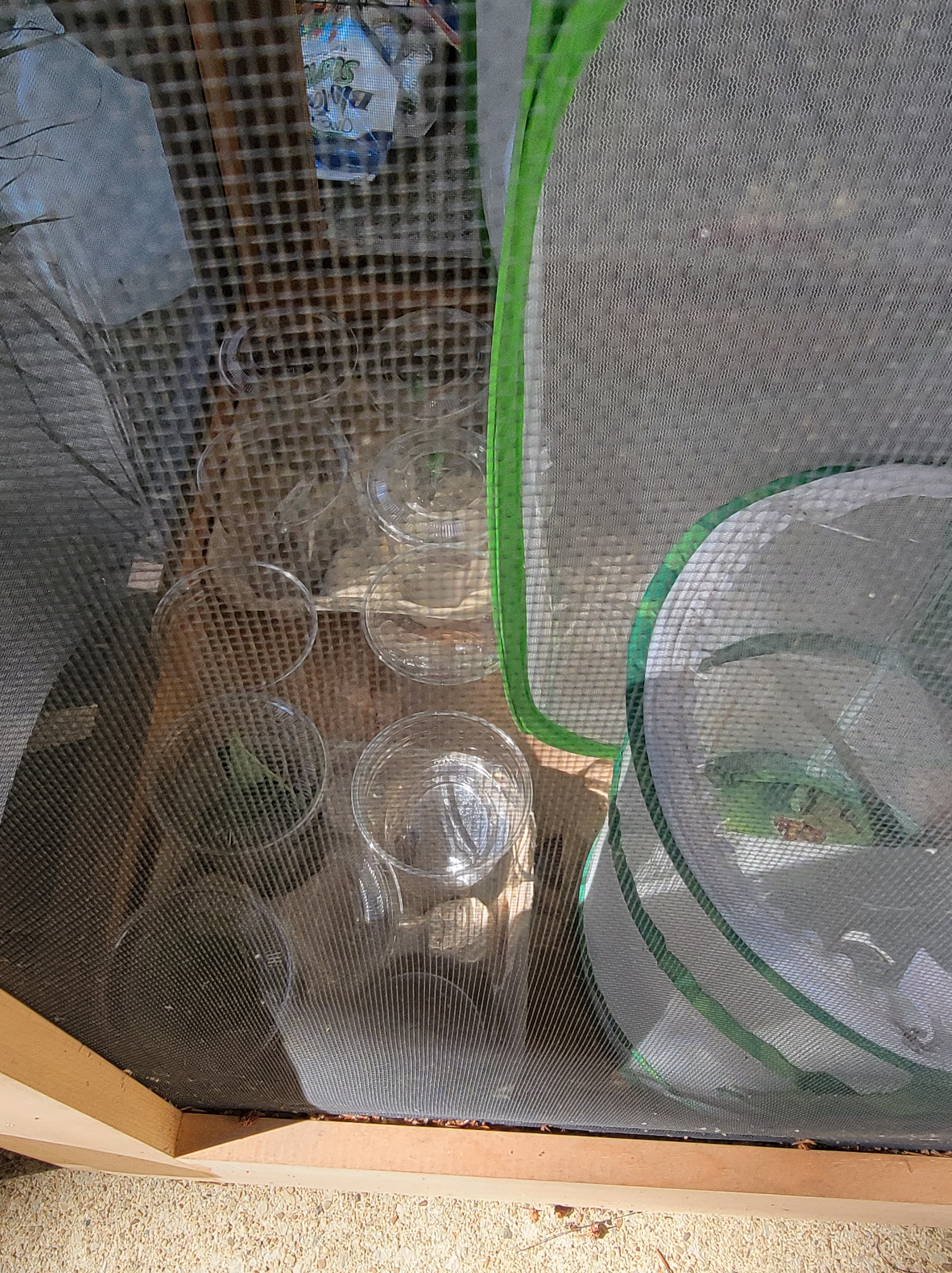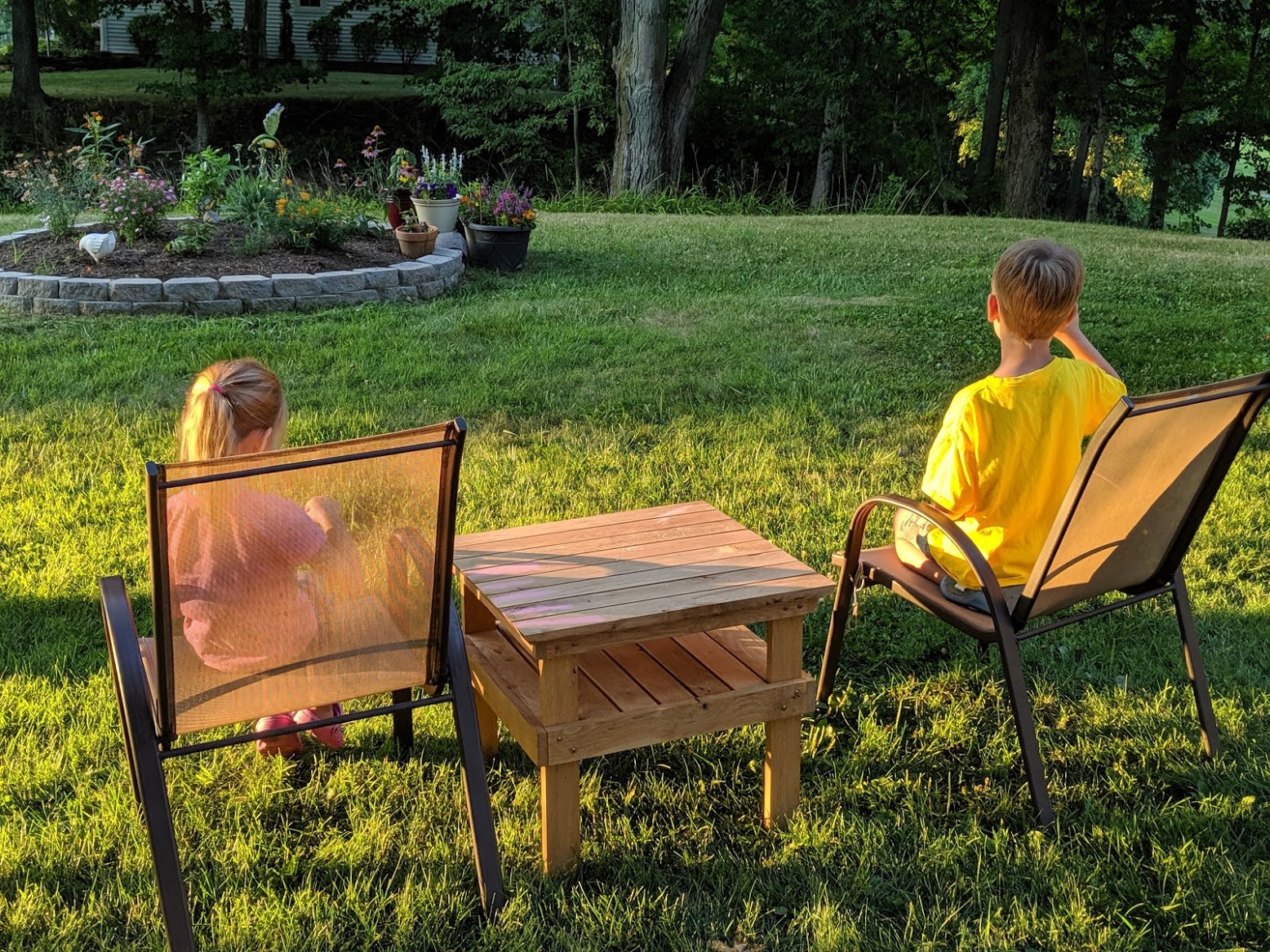A chrysalis fell! What do I do?
After you’ve been raising monarchs for a while, you will most assuredly run into the issue of a loose chrysalis. It happens! Sometimes it’s human error, sometimes the caterpillar is confused because it’s not in its natural environment, or who knows? There are a million situations in which a chrysalis may not be attached, and the long and the short of it is: What do I do now?
First of all, don’t panic! Yes, it could very well have been your fault, but remember: these are very fragile insects. It is entirely possible that in the wild a chrysalis would become detached from its branch, and what would happen then? It would fall to the ground, of course. Now, in the wild monarchs don’t have a very good survival rate, but for the sake of argument, let’s just assume this hypothetical chrysalis that fell from a tree actually survived the fall and doesn’t get consumed by a predator. What would happen?
The butterfly would eclose on the ground! Then, the butterfly would crawl up the tree to dry its wings.
If you ask the question of “What do I do if a chrysalis falls?” to an online monarch support group (i.e., on Facebook), you’ll get a lot of advice. Some of it is useful, some not, but it will be suggestions such as: use a Q-tip and the cremaster (“stem”) will stick to it like Velcro, then pin up the Q-tip. Or, tie dental floss around the cremaster and tie it to a twig.
If you would like to go that route, feel free. There’s nothing wrong with that. For myself though, I try to stick to nature as much as possible. I rarely, if ever, handle caterpillars, chrysalides, or adults. They are incredibly delicate, and humans are notoriously un-delicate in comparison. On the rare occasions that I’ve had a chrysalis fall, I simply place it on a napkin next to the edge of the enclosure. The butterfly will come out and crawl to the top, no harm done.
Proof in the puddin’, these three time-lapse videos that took place over about 10 minutes. Note: Speaking of “human error:” as soon as the butterfly started coming out I realized I was a bit of a bonehead by letting the napkin wrap up around the side instead of laying flat.
Copyright KEHC Photography, August 2021
Weeds amongst the weeds
I find it funny that I’ve had so much trouble getting a patch of weeds, I mean milkweed, to take. Part of the difficulty is that when autumn comes milkweed gets hit by the ugly stick, and I really don’t want to look at it all the time. I kept trying to find out-of-the-way places to plant it. Another issue was that when I started all this, I had no clue what I was doing, and I added a bunch of Swamp Milkweed (Asclepias incarnata), which turns out is not my favorite. I also made a bunch of other rookie mistakes that make me cringe now when I watch that video and remember how we did things. Please, please don’t get milkweed from your garden center like I did! Somehow I lucked out and I didn’t kill any caterpillars, but definitely take that as a lesson of What Not To Do.
All I can do now is move forward and “do my best with the information that I have.” I heard that somewhere and I think it is sound advice; you really can’t crucify yourself for mistakes you made in the past. You can’t know what you don’t know (more good advice), and I was clearly so proud of the milkweed we got from the garden center. I’m just glad that it didn’t end in disaster!
Anyway, last year I put this ring around our light pole, and this year we finally got it filled up with dirt. I guess next year I’ll finally get some plants in there! But right now, peeking through the out-of-control grass and weeds, you can finally, just barely, see my patch of Common Milkweed (Asclepias syriaca). If you’re having trouble locating it: look to either side of the light pole). There’s actually quite a bit in there, but it’s hidden in those heinous weeds.

Just a tad bit o’ rain
Maybe it’s just me, but when I look at this photo I hear Audrey and Rex singing, “The rain in Spain stays mainly in the plain!”

Welcome 2021 Cats!


Our 2021 Season
Our 2021 Season
- Months: July to September
- First adult sighting: July 1
- First egg sighting: July 10
- First caterpillar sighting: July 9
- First chrysalis: July 23
- First release: August 5
- Release dates: 8/5, 8/6 x2, 8/10 x3, 8/13, 8/14, 8/17, 8/18, 8/19, 8/23, 8/26, 8/29, 8/31 x2, 9/3, 9/5 x5
- Last release: September 27
- T-fly deaths: 1
- Other deaths: 3
- Current stats: 8/24: cats-3, chrysalides-9, total possible-24
- 8/26: babies-4, cats-1, chrysalides-11, larva/cat-19
- 8/26: release-1
- 8/29: babies-4, cats-1, chrysalides-10, release-1
- 8/31: babies-6, chrysalides-8
- 9/5: cats-6, chrysalides-2, released-5
- 9/14: cats-0, chrysalides-6, eclosed-1, OE death-1
- 9/19: tfly-1
- 9/25: Released-1, Chrysalides-5
- 9/26: Released-1, Chrysalides-4
- Total possible: 28
- Total released (YTD): 28
Notes on our season
- Very wet this year. Seems to be delaying everything.
- Finally got a patch of common milkweed well underway.
- The enclosure is warped and my husband doesn’t have time to repair it, so we’re making due with pop-up enclosures and it’s really affecting our numbers.
Last update: 9/27/21
Gallery
How to care for your monarch from egg to butterfly in 10 steps
It’s okay if you’re just starting out and you’ve already found caterpillars or eggs… There isn’t much to do in the beginning. You have plenty of time to get ready!
Setting up your rearing station
Once you find an egg or caterpillar:
- If it’s an egg: transfer the egg on a piece of leaf (you do not need the entire leaf) and put it into a small cup or container (no air holes needed). If it’s a caterpillar, skip to step 3.
- Get excited, and wait for it to hatch. Check it daily until it hatches, and if the milkweed dries up, add a small piece of fresh.
- Your caterpillar must have a supply of fresh milkweed at all times. Clean out poop/frass daily (although the tiny cats’ frass is miniscule).
- Sometime on Day 1 you’ll panic that it got lost or crawled out. Take a deep breath, check the lid and under the leaf until you find it.
- After a day or two of constant checking, now it’s time to notice your cat isn’t moving much and doesn’t appear to be eating. Panic that something is wrong, (Note: something might be wrong, or it might be fine). Post pictures in multiple monarch butterfly Facebook groups asking for help, only to learn that it’s shedding its skin, or molting. Google “how long does it take for a monarch caterpillar to molt” (answer: 12-24 hours) and breathe a sigh of relief. Do not disturb during molting!
- Repeat steps 3-5 for each time your caterpillar sheds. Google “How many times does a monarch caterpillar molt?” (answer: 4) This is when you’ll learn the different phases between a caterpillar’s molts are called instars. 3rd instars should be transferred from a cup to a larger enclosure, preferably with cuttings instead of individual leaves. Once a cat reaches 5th instar it will pupate within a few days.
- After a few days in 5th instar, your cat will crawl to the top of your enclosure and hold very still, sometimes for more than a day! Do not disturb it. Soon it will hang upside down in the shape of a J, and that’s when it is very close to pupating. Sit and watch it for hours. When the antennae are droopy pupation is imminent. Just when you go to the bathroom or answer the door or something, you’ll return and find your cat pupated while you weren’t looking. Admire the beautiful jade green chrysalis.
- After several days, you’ll notice the chrysalis start to change color. Panic that something is wrong. Note: something might be wrong, or it might be fine.
- When the chrysalis seems to turn black, look closer. You should see that the chrysalis is actually clear, but appears black because you’re seeing the monarch inside. Once it turns clear, your butterfly will probably eclose within a day (not hatch… Only eggs hatch. Adult butterflies emerge, or eclose).
- Keep your friend for 24 hours before you release it. Their wings need time to dry and harden. Even if they seem anxious to go and are fluttering wildly, note that they do not eat for the first 24 hours. They do this because after their wings dry their instinct is to fly away from their old chrysalis to a quiet tree for their wings to fully harden. This is a very vulnerable time for them, so do your butterfly a favor and keep them safe.
More information:
How long does it take?
Here are some average time frames for the major life events in a monarch’s life. There is some variation, partly because every individual is different, and partly because temperature matters. Warmer temps will speed things up, cooler temps (e.g., autumn, air conditioning) will slow things down… Okay, here we go!
Egg: 3-5 days from time of laying to hatch.
Molting between instars: 24-36 hours
Caterpillar stage (will molt 4 times): 10-12 days total
J-hang: 12-24 hours
Pupating, start to finish: the exact length of time for an adult to use the restroom, so about 3 minutes (or less if you pee fast).
Chrysalis: 10-12 days
Eclosing: under 1 minute when chrysalis pops open. Note proper terminology: adult butterflies do not “hatch.”
Pumping wings: 20 minutes to fill out
Drying wings: 2-4 hours
Amount of time recommended before releasing: 24 hours. Even if they seem anxious to go and are fluttering wildly, note that they do not eat for the first 24 hours. After their wings dry (2-4 hours from emerging) their instinct is to fly away from their old chrysalis to a quiet tree for their wings to fully harden. This is a very vulnerable time for them, so do your butterfly a favor and keep them safe.
The entire life cycle of generations 1-3: 2-4+ weeks+
Entire left cycle of generation 4 (migrators): ~8 months, however they are not active for that entire time. Overwintering monarchs go into a dormant state, similar concept as hibernation.
+Except the generation that migrates to Mexico (or, if you’re on the West Coast, monarchs overwinter along the central coast of California). There may be an overlap with Migrators further North and year round butterflies in California.
More information:
A friendly debate about migration and raising caterpillars
Recently, I got into a debate on Facebook with a rando stranger. That’s always fun, eh? It did make me realize there is a lot of confusion out there. Even the terminology is inconsistent! So let’s get that out of the way first:
- Monarch: can refer to caterpillars or adult butterflies. Usually contextual clues are used to differentiate.
- Raising/rearing: these interchangeable terms are a reference to any person, group, or corporation that is keeping caterpillars. How the caterpillars are obtained and the methods used to keep them alive are a secondary distinction. Whether you’re an old lady with curlers in her hair or a large corporation selling to schools, a five year old boy or a bachelor giving them to his friends, if you have caterpillars in a pop-up tent or a Mason jar or a factory or anywhere in between, if you have altered conditions in any way from Mother Nature, then you are raising/rearing monarchs.
- Captive Rearing: technically the same as rearing/raising above, but in actual practice is typically in reference to a breeder.
- Hobbyist/enthusiast: (interchangeable) A person/family raising caterpillars born in the wild at their home (either indoors or out), and releasing adult butterflies back into the wild. It’s probably you, dear Reader, as I highly doubt my blog is big enough to have reached a large-scale corporation.
- Breeder: A person or business that that keeps adult butterflies in captivity on a large scale, and sells the eggs and caterpillars for profit (for example, to a school for classroom learning).
Okay, back to the point: my Facebook debate was regarding migration. It was a friendly conversation, so I figured it deserved a F.R.I.E.N.D.S.’ly response.
There have been many articles shared within the hobbyist community with some version of this headline: “Monarchs raised in captivity lose ability to migrate.”
The debate I got into began with an enthusiast’s comment: “I am only raising the caterpillars and not the butterflies. The day they become butterflies, they are set free in my back yard so I am assuming this does not refer to me.”
Which made my stickler for accuracy, “I love words,” English Major’s head POP OFF. I tried so hard to just let it go, but it just drove me insane. I couldn’t! How could I? I’m my mother’s daughter, after all. Of course, I had to speak up.
For simplicity, I’ll refer to commenter as a woman named Janice (yes, the first of many Friends references and attempts at cleverness. Forgive me). After reading her comment, it really felt like this rando Facebook stranger that I’ve nicknamed Janice also symbolizes everything that is wrong with the world: An ignorant attitude with no desire to learn, zero sense of responsibility, and a dismissive “I didn’t know so it’s not my fault,” mentality.
“I am only raising the caterpillars and not the butterflies”?! Oh. My. Gosh. What does that even mean! You can’t “raise” butterflies… They’re all adults! They don’t grow. You can keep them in captivity or release them, but the raising has nothing to do with adult butterflies. Yes, the @#&$ article refers to you, Janice! It refers to all of us! The only two people that are exempt from the article are God and Mother Nature.
“The day they become butterflies, they are set free in my back yard,” Janice continued. That just means you’re not keeping adults in captivity; that you’re not breeding monarch butterflies. But if you have 1 pop-up tent or 15, or whether you bring caterpillars in from the milkweed in your back yard, down the road, or a field two towns over. It makes no difference if you are keeping them in your home, your New York apartment over Central Perk, on your porch, or putting a tomato cage around a milkweed plant and throwing mesh over it… Those details don’t matter as far as terminology goes. When a caterpillar is in an altered environment—even if the alteration is just a lack of predators—if the caterpillar is unable to leave that is pretty much the definition of captivity. Whether the caterpillar would choose to stay or not is irrelevant… It’s still in captivity. It applies to you, Janice!
All that said and liberally punctuated with exclamation points, until recently the bulk of those articles didn’t really apply to hobbyists. Let’s take a moment to giggle together at how fired up I was over a “moo” point. Previously, studies did not take into account an important distinction between a hobbyist and a breeder: the source of the caterpillars which will turn into the butterfly being studied.
A hobbyist is almost certainly getting their caterpillars from eggs that were laid by a monarch butterfly living in the wild. A breeder is almost certainly raising caterpillars whose parents were not only kept in captivity, but most likely born in captivity too. For many generations. For more information about these studies, check out a video by Mr Lund Science here.
The studies were performed on wild versus bred butterflies, which means the article professing that “captive monarchs can’t migrate” is leaving out the average hobbyist like myself, Janice, and undoubtedly you too. Shall I call you Monica or Joey?
The studies concluded that butterflies who have been in captivity for generations were less likely to orient south. Therefore, as far as enthusiasts were concerned, the entire article was “like a cow’s opinion. It doesn’t matter.” Hobbyists proclaimed that they have been raising caterpillars indoors for some time now, and their tagged adults were showing up in Mexico. It seemed like all the evidence was pointing to the same conclusion: the studies only apply to large-scale facilities keeping monarchs in captivity for generations.
Skip forward to August 2020: some researchers started looking a little closer at the data, and now the rate of success has been put into the spotlight. Instead of taking it at face value that tagged butterflies are showing up in Mexico, now researchers want to know who they are, where they come from, and what conditions they lived in while developing: “… there are two published and widely cited studies suggesting that reared monarchs do not orient properly or are too small or weak to reach Mexico. While that may apply to some reared monarchs, the rate of recovery of reared monarchs in Mexico suggests that the outcome could be improved if we developed a better understanding of the rearing and other conditions that lead to the highest rates of success.” (Monarch Watch)(emphasis mine)
Again, thanks to tagging we know absolutely there are caterpillars raised by hobbyists and released as adult butterflies that are making it to Mexico. However, the rate of success depends on a multitude of factors that require further study. Even though “… tagging records indicate that thousands of reared, tagged and released monarchs arrive at the overwintering sites in Mexico and survive through the winter, it is also clear that the likelihood of reaching Mexico is lower for reared monarchs. We want to know why. We need to sort out why some people who rear, tag and release have much higher recovery rates than others.” (Monarch Watch)(emphasis mine)
Therefore, new studies are being performed and published which are taking hobbyists into account. But, since there is such a variety in the conditions (indoors vs outdoors, plastic cup versus mesh cage, and so forth), it’s as complicated as whether or not Ross and Rachel were on a break when you try to answer the question, “Can they migrate or not?”
One such new study, “published in Proceedings of the Royal Society B on August 5, 2020, had two components: one looked more closely at the flight behaviors of individual commercially bred monarchs by tracking their flights repeatedly, and the other at the effects of natural sunlight exposure on the migration behavior of wild-bred monarch butterflies.” (phys.org)(emphasis mine)
More from that article: “To further pick apart the cues that trigger migration, the researchers opted to raise the wild monarchs in a greenhouse, where the butterflies were exposed to true sunlight throughout the day, as well as raising the insects in the lab near a south-facing window and in a large outdoor cage.
To their surprise, the natural light wasn’t enough to trigger the appropriate orienting behavior. Compared to the monarch butterflies raised in the outdoor cages, the ones raised in the greenhouse were worse at flying south.” (phys.org)(emphasis mine)
And finally, the researchers are asking: “Is it the sunlight, is it the location of the sun in the sky, is it a change in the plants or in the temperature? Is one of those cues the most critical, or is it a combination? Is there a critical period during the monarch’s life cycle for these cues to have the right effect? We just don’t know.” (phys.org)(emphasis mine)
It turns out the issue was much more complex than it seemed at first glance. Hobbyists should start paying more attention to these studies, because to all the Janices out there: it does refer to us!
Hobbyists can help increase data by filling out this survey for Monarch Watch and providing details about your set-up (click here).
So what’s the take away?
Please, to the best of your ability, keep conditions for your captive monarch caterpillars as natural as possible. In my opinion, based on what I’ve read, lighting and temperature seem to be the most important factors at this time. For that reason, based on what I’ve read, my official opinion at this time is that an outdoor fine mesh enclosure out of direct sunlight is best practice.
VERY IMPORTANT: hobbyists should not read this as a call to arms, nor an invitation for a witch hunt! When looking at the big picture, I refuse to believe that someone who found a couple caterpillars in their garden and took them inside their house to watch and protect has done anything wrong. Sure, we can gently suggest more natural conditions. We can promote education and guide them to good resources. But these people—including you, Janice!—are NOT the problem. They are trying very hard to make a difference and monarchs need people like in their corner.


















